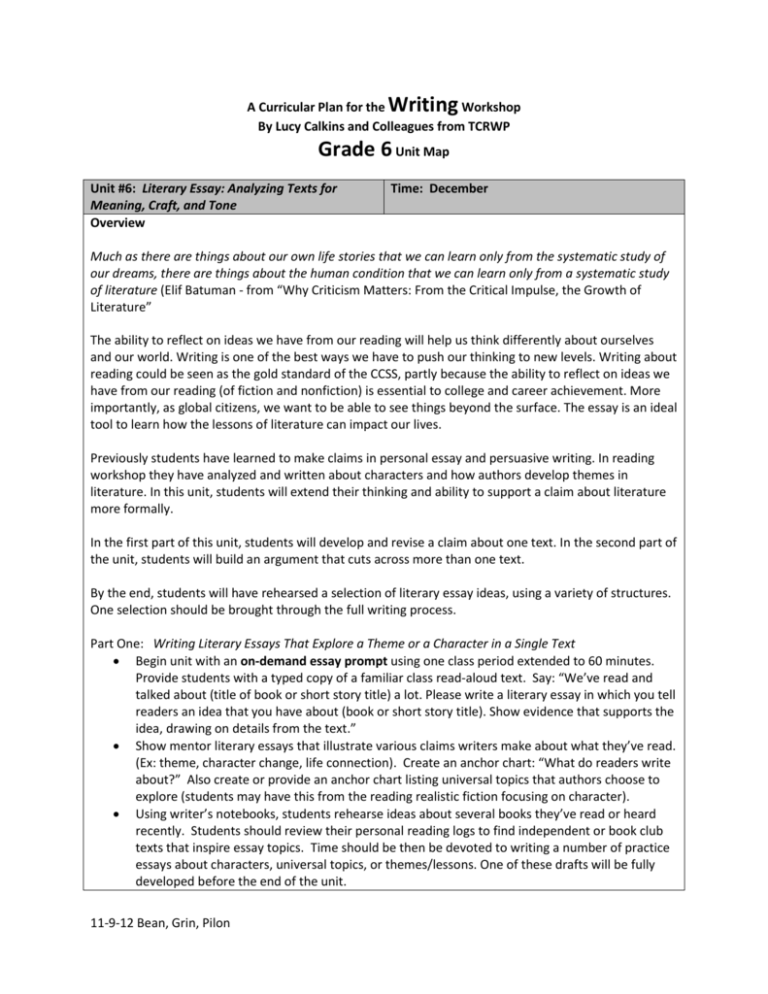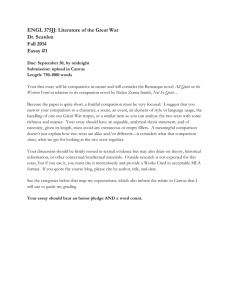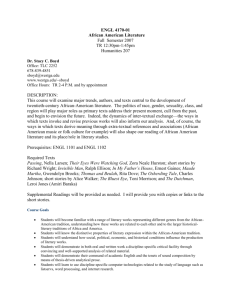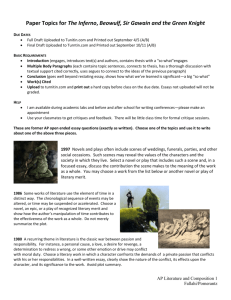Grade 6
advertisement

Writing A Curricular Plan for the Workshop By Lucy Calkins and Colleagues from TCRWP Grade 6 Unit Map Unit #6: Literary Essay: Analyzing Texts for Meaning, Craft, and Tone Overview Time: December Much as there are things about our own life stories that we can learn only from the systematic study of our dreams, there are things about the human condition that we can learn only from a systematic study of literature (Elif Batuman - from “Why Criticism Matters: From the Critical Impulse, the Growth of Literature” The ability to reflect on ideas we have from our reading will help us think differently about ourselves and our world. Writing is one of the best ways we have to push our thinking to new levels. Writing about reading could be seen as the gold standard of the CCSS, partly because the ability to reflect on ideas we have from our reading (of fiction and nonfiction) is essential to college and career achievement. More importantly, as global citizens, we want to be able to see things beyond the surface. The essay is an ideal tool to learn how the lessons of literature can impact our lives. Previously students have learned to make claims in personal essay and persuasive writing. In reading workshop they have analyzed and written about characters and how authors develop themes in literature. In this unit, students will extend their thinking and ability to support a claim about literature more formally. In the first part of this unit, students will develop and revise a claim about one text. In the second part of the unit, students will build an argument that cuts across more than one text. By the end, students will have rehearsed a selection of literary essay ideas, using a variety of structures. One selection should be brought through the full writing process. Part One: Writing Literary Essays That Explore a Theme or a Character in a Single Text Begin unit with an on-demand essay prompt using one class period extended to 60 minutes. Provide students with a typed copy of a familiar class read-aloud text. Say: “We’ve read and talked about (title of book or short story title) a lot. Please write a literary essay in which you tell readers an idea that you have about (book or short story title). Show evidence that supports the idea, drawing on details from the text.” Show mentor literary essays that illustrate various claims writers make about what they’ve read. (Ex: theme, character change, life connection). Create an anchor chart: “What do readers write about?” Also create or provide an anchor chart listing universal topics that authors choose to explore (students may have this from the reading realistic fiction focusing on character). Using writer’s notebooks, students rehearse ideas about several books they’ve read or heard recently. Students should review their personal reading logs to find independent or book club texts that inspire essay topics. Time should be then be devoted to writing a number of practice essays about characters, universal topics, or themes/lessons. One of these drafts will be fully developed before the end of the unit. 11-9-12 Bean, Grin, Pilon Define thesis statement, and find examples in mentor text. Teach possible organizational structures. (see Literary Essay Structures handout) Review with students how to locate text evidence to support a claim and how to incorporate it (paraphrase, direct citations, partial quotes) into text. (see models from Letters about Literature) Show students how to choose the most compelling evidence and make its purpose clear to someone who hasn’t read the text. Teach partners to ask, “I’m not sure how I see how this fits…”Can you say why this evidence shows…” Students can then rewrite to fill the holes and get rid of irrelevant details. Demonstrate how revision of evidence may lead to revision of thesis. For students who use the structure to connect a personal experience to their claim, remind them about the strategies of personal narrative (zoom in, stretch the moment or anecdote that is being compared.) Part Two: Writing across Texts to Explore the Different Treatment of Similar Themes Teach comparative essay structure – an essay in which a writer takes on a universal topic that emerges in more than one text, and that may have the same theme or a differing view/theme. Introduce cross medium by asking students to compare a scene from text with a video clip or theater production of the same scene. Show students how to revise for coherence, flow and effect. Require students to finalize one literary essay idea using the full writing process. Administer the post-assessment (Grade 6 Literary Essay Performance Assessment). During this unit: During this unit, conduct most mini-lessons at the beginning or the unit, leaving time for small group and individual conferences while students revise and refine their essays. At the end of the unit, provide time for students to reflect about their growth as they compare their pre and post assessments. Writing: Text Types and Purposes 6.W.01 – Write arguments to support claims with clear reasons and relevant evidence. a. Introduce claim(s) and organize the reasons and evidence clearly. b. Support claim(s) with clear reasons and relevant evidence, using credible sources and demonstrating an understanding of the topic or text. c. Use words, phrases, and clauses to clarify the relationships among claim(s) and reasons. d. Establish and maintain a formal style. e. Provide a concluding statement or section that follows from the argument presented. Production and Distribution of Writing 6.W. 04 – Produce clear and coherent writing in which the development, organization, and style are appropriate to task, purpose, and audience. 6.W.05 – With some guidance and support from peers and adults, develop and strengthen writing as needed by planning, revising, editing, rewriting, or trying a new approach. (Editing for conventions should demonstrate command of Language standards 1-3 up to and including grade 6 on page 52.) 6.W.09 – Draw evidence from literary or informational texts to support analysis, reflection, and research. 11-9-12 Bean, Grin, Pilon a. Apply grade 6 reading standards to literature (Compare and contrast texts in different forms or genres) Range of Writing 6.W.10 – Write routinely over extended time frames (time for research, reflection, and revision) and shorter time frames (a single sitting or a day or two) for a range of discipline specific tasks, purposes, and audiences. Speaking and Listening: Comprehension and Collaboration 6.SL.03 – Delineate a speaker’s argument and specific claims, distinguishing claims that are supported by reasons and evidence from claims that are not. Language: Conventions of Standard English 6.L.01 – Demonstrate command of the conventions of standard English grammar and usage when writing or speaking. e. Recognize variations from standard English in their own and others’ writing and speaking, and identify and use strategies to improve expression in conventional language. 6.L.02 – Demonstrate command of the conventions of standard English capitalization, punctuation, and spelling when writing. a. Use punctuation (commas, parentheses, dashes) to set off nonrestrictive/parenthetical elements. b. Spell correctly. Knowledge of Language 6.L.03 - Use knowledge of language and its conventions when writing, speaking, reading, or listening. a. Vary sentence patterns for meaning, reader/listener interest, and style. b. Maintain consistency in style and tone. Vocabulary Acquisition and Use 6.L.06 – Acquire and use accurately grade-appropriate general academic and domain-specific words and phrases: Gather vocabulary knowledge when considering a word or phrase important to comprehension or expression. Essential Questions for Students Guiding Questions for Teachers How can I use essay writing to develop big, insightful and wise ideas about the human experience? How can I help students use writing to analyze literature as a way to grow ideas about themselves and the world that surrounds them? How do I develop a thesis about literature and build an effective structure to support my claim? How can I help students clarify and support what they are trying to say about literature? How should I select the most compelling evidence to support my claim? 11-9-12 Bean, Grin, Pilon How will I help students transfer the thinking skills they learn from writing literary essays to their everyday reading life? Stage 2– Common Assessment – What is the evidence of understanding? Universal Screens Formative Assessment Strategies Grade 6 Literary Essay Criteria Checklist Grade 6 Literary Essay Performance Assessment (post-assessment) On-demand literary writing pre-assessment – “We’ve read and talked about (title of book or short story) a lot. Please write a literary essay in which you tell readers an idea that you have about (title of book or short story) Show evidence that supports the idea, drawing on details from the text.” Stage 3 – Instruction – What learning experiences will lead to understanding? Skills: Key Terms/Vocabulary developing a thesis generating (ideas) anecdote structuring a literary essay flashdraft compelling supporting a claim annotate interjection incorporating the most compelling text thought prompt simple sentence evidence gracefully thesis statement compound sentence writing for an audience claim complex sentence writing fluently (quickly with structure) angle transitional words varying sentence structures counter-argument transitional phrases using transitional words verb tense using verb tenses consistently One Possible Sequence of Teaching Points (A Note To Teachers: Please remember that this one possible sequence of teaching points. Based on the students in your class, you may decide to spend more time on some things and less on others. This is a guide to help you make decisions based on the learners in front of you.) Part One: Writing Literary Essays That Explore a Theme or a Character in a Single Text “As we construct possible ideas we want to explore in essays, writers know that literary essayists often write about characters—about the lessons they learn, about how they change, about what they teach us. We also sometimes write about important ideas, issues, or lessons we learn from stories and the parts of the story that suggested that lesson. As we come up with ideas, if a community of writers charts those ideas, we’ll often see that some ideas are true in different stories—they are themes—and writers can adapt and appropriate ideas from each other.” “As we rehearse ideas about characters, lessons, issues, or themes, we may also write moments in our lives when we have learned a similar lesson or that illustrate the same idea, issue, or theme. We may use this moment later in our essay.” “Writers know that stories have more than one meaning. We use our notebooks to explore ideas we have about the stories we love. We jot down an idea, we look back over our Post-its or notebook pages, we flip through the text, and we gather moments in the story that support our idea. Often we retell those moments in our notebooks, doing an angled retelling or quoting an important part and then summarizing the part of the story we excerpted it from.” “Writers often sort through the moments we have gathered, and we think about which 11-9-12 Bean, Grin, Pilon moments from the story most make our idea visible. Sometimes we refine or change our idea as we look at these moments. Sometimes we discard some moments from the story. Sometimes we go back to the text to seek new evidence. All this work we can do by talking to a partner as well—we use our partner to rehearse ideas. Sometimes it helps if partners decide to write about a text both partners have read, so we can help each other gather evidence.” “As we try out our ideas, there are some prompts that may help us write more about our ideas, such as: This makes me realize . . . I still wonder . . . On the other hand . . . Another way to say this might be . . . This reminds me of, in my life, a moment when . . .” “Writers often try rehearsing a few ideas, either about the same stories or different ideas about different stories, and we do this by jotting our ideas and then listing, retelling, and analyzing the pivotal moments in the story that supports our idea. As we look at our ideas and evidence, we keep asking ourselves: ‘What does this moment really teach the character, or the reader?’ We also may ask: ‘What does this book have to say about . . .’” “Sometimes, if we find ourselves stuck in supporting our idea, we may have an idea that was only true at the end of the story, and we may need to revise our idea if we are to find multiple moments in a story as evidence. We may modify our idea to ‘At first it seems like . . .but then . . .’” As we go to draft our essays, we use what we know about essay structure, often following the simple structure of Claim or idea ● Support from one place in the text ● Support from another place in the text ● Support from a third place in the text Reflection/insight/realization” “Another structure that we might enjoy writing in is the literary essay structure in which we compare a moment in a story to a moment in our life, to support an idea that feels true in the story and our life. To do that, we may draft in this structure: Claim or idea ● A moment from the text that evokes this idea ● A moment from our life that evokes this idea Reflection/insight/realization” “Once we have a draft in hand, we do some revision. One revision strategy literary essayists employ is to reconsider our evidence, asking, ‘Does this really get to the idea I’m writing about?’” “Other revision strategies include: - Repeating our thesis statement as part of the topic sentence for our body paragraphs, to make sure our idea carries through our essay. Sometimes we find ourselves shifting to a variant of our idea, or a slightly different idea, so reinserting the thesis holds us to the original idea. We can always shift the language of the topic sentence, but using the same phrase for the thesis part can be helpful. - Using what we know about narrative writing to retell parts of the story with vivid detail. - Describing the story in such a way that it makes the reader want to read that story. We are passionate about the significance of the story. 11-9-12 Bean, Grin, Pilon - Using our conclusion to return to our life and suggest the implications for the lessons or ideas from the story in making changes in our own lives. - Considering some grammar moves, such as checking our verb tenses. Usually literary essayists state their ideas in present tense and quote the text in past tense. We also make sure we have quoted accurately, and we check the punctuation of our quotes. When we cite, short stories are usually in quotes and book titles are usually underlined or italicized. We usually give the page number in parentheses after a quote or reference.” Part Two: Writing across Texts to Explore the Different Treatment of Similar Themes “Writers know that sometimes we compare texts. Often we begin by recalling and talking about texts we have most loved and thinking about similarities in these texts. The characters or the issues the texts make visible may be similar or they may suggest similar themes. It’s often helpful for a community of writers to chart the texts they have in common and some of their themes and important characters. These tools help us to recall favorite and important literature. We then write long about themes, issues, and ideas that matter to us across a couple of texts.” “As soon as we have an idea that is true in more than one text, we begin to explore how different authors interpret that idea. For instance, rather than saying, ‘The Hunger Games and Thirteen Reasons Why are both about growing up,’ we might say, ‘The Hunger Games and Thirteen Reasons Why offer different interpretations of what it means to grow up. Suzanne Collins, in The Hunger Games, suggests that to grow up, we must learn to sometimes sacrifice our own wishes. Jay Asher, in Thirteen Reasons Why, leaves us with the idea that growing up means realizing how much our actions affect others.’” “As we link texts thematically, we focus on analyzing their differences. Often that means returning to the texts and really thinking about what’s different about them, including differences in time and place, in characters’ traits and changes, and in the way that characters encounter similar issues or make a theme visible. Each of these differences affects our understanding of the text. Literary essayists, therefore, are nuanced readers and writers, and once we have an overarching similarity that unites two texts, we spend a lot of time as writers analyzing what’s different about the stories and how those differences matter to the stories’ meanings.” “Literary essayists know that it’s often helpful to know something about how we may structure our essay, so that we know if we’re collecting and rehearsing all the potential parts. We may, therefore, want to consider these structures: Idea/thesis ● How one text evokes this idea ● How a different text evokes this idea in a different way Reflection/realization/insight or Idea/thesis ● How two texts are similar in their treatment of this idea ● How the texts are different in their treatment Reflection/realization/insight or Idea/thesis ● Support from more than one text ● How the writer’s experience supports this idea in similar and different ways Reflection/realization/insight” 11-9-12 Bean, Grin, Pilon “As we rehearse and then begin drafting our essays, we know to use our full repertoire, or toolkit of strategies, including: Drafting in essay structure Really returning to texts to mine them for the best evidence Quoting and paraphrasing and incorporating vivid details Making sure to analyze the text evidence we include Using transitions to move our reader along coherently Using citation to reference texts accurately” “As we look over our essays, sometimes we realize that we need to reconsider our structure. Perhaps we have more support for a different structure. Or, we may need to reconsider our thesis and revise it to match our evidence more closely. We may need to return to the text, for more or sharper evidence.” “We often study our essays with a partner, especially one who has read the same texts, asking, ‘Where are there holes in my argument?’ and ‘What other evidence might I include?’ and ‘Where could I say more about why and how my evidence is compelling? Am I analyzing my evidence enough?’” “We may also revise for compelling craft. We may, for instance: Pace for suspense in retelling a scene. Sometimes say what a character didn’t do, as a comparison and to highlight the significance of what he or she did do. Comment not just on what happens in the story, but in how the author has told the story. We might discuss the narrator’s point of view, or contrasting points of view, or the pacing to build suspense, or indelible images, or symbolism, or repetition, or embedded discourse. Revise to use the more inclusive we instead of I in an essay, or to include the reader instead of I.” “We may try to include a counter-argument, such as ‘Others might think . . . but . . .’ or ‘Before reading these stories, one might think . . . but afterward, a conclusion we may draw is . . .’” Resources: Literary Essay Structures (handout) Calkins, Lucy and Colleagues. 2011. A Curricular Plan for The Writing Workshop, Grade 6. Portsmouth, NH: Heinemann. Calkins, Lucy and Cory Gillette. 2006. “Literary Essays: Writing About Reading” from Units of Study for Teaching Writing, Grades 3-5. Portsmouth, NH: Heinemann. TCRWP Continuum for Assessing Opinion/Argument Writing Mentor Texts: Student Mentor Literary Essay Collection Teacher selected favorite read-alouds (picture books, novels, short stories, narrative nonfiction) that have been shared as a class 11-9-12 Bean, Grin, Pilon Freedom Summer by Deborah Wiles The Other Side by Jacqueline Woodson Fly Away Home by Eve Bunting Websites and Technology: http://readingandwritingproject.com/resources/student-writing/middle-school.html 11-9-12 Bean, Grin, Pilon








